Pharmaceutical Distribution: Ensuring Efficient Supply Chain Management for Improved Healthcare Access

Pharmaceutical distribution plays a pivotal role in the healthcare industry, bridging the gap between pharmaceutical manufacturers and patients. An effective distribution system is essential to ensure the timely availability of medications and healthcare products, ultimately contributing to improved patient outcomes and public health. This article explores the key components of pharmaceutical distribution, challenges faced by the industry, and innovative solutions to enhance efficiency and accessibility.
- Introduction: Pharmaceutical distribution encompasses the processes involved in the movement of pharmaceutical products from manufacturers to healthcare facilities, pharmacies, and ultimately to patients. A well-organized distribution system is critical to meet the ever-increasing demand for medicines worldwide and guarantee equitable access to healthcare services.
- Key Components of Pharmaceutical Distribution: a. Manufacturer-Wholesaler Relationship: Pharmaceutical manufacturers establish partnerships with wholesalers to distribute their products to a broader market. Wholesalers act as intermediaries, aggregating products from multiple manufacturers and supplying them to various retail outlets.
b. Retail Dispensing: Retail pharmacies and healthcare facilities serve as the primary points of access for patients. They receive pharmaceutical products from wholesalers and ensure they reach the end-users efficiently.
c. Storage and Warehousing: Adequate storage facilities are essential to preserve the integrity and quality of pharmaceutical products. Temperature-controlled warehousing is crucial, particularly for vaccines and sensitive medications.
d. Transportation: The transportation network must be reliable and efficient, ensuring the timely delivery of medicines to various locations. Proper logistics management minimizes the risk of stockouts and wastage.
- Challenges in Pharmaceutical Distribution: a. Cold Chain Management: Maintaining the cold chain during transportation and storage is vital for temperature-sensitive drugs. Any deviation from the required temperature range can compromise the efficacy of medications.
b. Supply Chain Fragmentation: In many regions, the pharmaceutical supply chain is fragmented, leading to inefficiencies, product shortages, and increased costs.
c. Counterfeit Medications: Illicit distribution channels can introduce counterfeit drugs into the market, posing significant health risks to patients and undermining trust in the healthcare system.
d. Regulatory Hurdles: Each country has its regulatory framework governing pharmaceutical distribution, making cross-border distribution complex and time-consuming.
- Innovative Solutions for Efficient Pharmaceutical Distribution: a. Blockchain Technology: Implementing blockchain can enhance supply chain transparency and traceability, reducing the risk of counterfeit drugs and streamlining regulatory compliance.
b. Data Analytics: Leveraging big data and analytics can optimize inventory management, demand forecasting, and distribution routes, leading to cost savings and improved efficiency.
c. Drones and Autonomous Vehicles: Unmanned aerial vehicles and autonomous delivery systems can revolutionize pharmaceutical distribution in remote and hard-to-reach areas, ensuring timely access to medicines.
d. Public-Private Partnerships: Collaborations between governments, pharmaceutical companies, and non-governmental organizations can strengthen distribution networks and improve last-mile delivery.
- Conclusion: Pharmaceutical distribution is a critical component of the healthcare ecosystem, ensuring that patients have timely access to essential medications. Overcoming the challenges in distribution requires innovative technologies and collaborative efforts among stakeholders. By investing in efficient distribution systems, we can promote better healthcare access and ultimately improve global public health.




